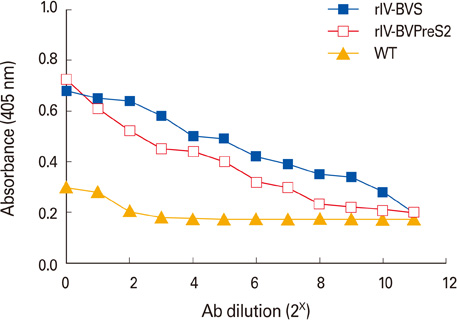Clin Exp Vaccine Res.
2012 Jul;1(1):77-82. 10.7774/cevr.2012.1.1.77.
Recombinant influenza viruses as delivery vectors for hepatis B virus epitopes
- Affiliations
-
- 1Department of Global Medical Science, College of Nursing, Sungshin Women's University, Seoul, Korea. jmsong@sungshin.ac.kr
- 2Department of Biotechnology, College of Life Science and Biotechnology, Yonsei University, Seoul, Korea.
- KMID: 2278791
- DOI: http://doi.org/10.7774/cevr.2012.1.1.77
Abstract
- PURPOSE
Neuraminidase (NA) of influenza virus contains stalk region that shows a great deal of variability in both amino acid sequence and length. In this paper, we investigated generation of recombinant influenza viruses that had hepatitis B virus (HBV) B cell epitopes in the NA stalk region as a dual vaccine candidate.
MATERIALS AND METHODS
We used the WSH-HK reassortant helper virus for rescue of recombinant influenza virus containing HBV epitopes and reverse genetic protocol based on the use of micrococcal nuclease-treated virus cores for reconstitution of ribonucleoproteins.
RESULTS
We successfully generated a chimeric influenza viruses which contained 22 amino acid peptides in the stalk region derived from the surface and pre-surface protein HBV. The growth kinetics of the recombinant viruses was investigated after infection of Madin-Darby canine kidney (MDCK) and Madin-Darby bovine kidney (MDBK) cells and the rIV-BVPreS virus showed higher titer than other viruses in MDCK cells. We also confirmed the presence of HBV epitopes in the chimeric viruses by enzyme-linked immunosorbent assay (ELISA) using anti-HBV polyclonal antibody. When the ratio of recombinant virus verse wild type virus was calculated by ELISA, recombinant viruses exhibited 2 fold higher values than the wild type virus.
CONCLUSION
These results suggest that chimeric influenza virus which contained foreign antigens can be used as dual vaccine against both HBV and influenza viruses.
Keyword
MeSH Terms
Figure
Reference
-
1. Baum C, Schambach A, Bohne J, Galla M. Retrovirus vectors: toward the plentivirus? Mol Ther. 2006. 13:1050–1063.
Article2. Li C, Bowles DE, van Dyke T, Samulski RJ. Adeno-associated virus vectors: potential applications for cancer gene therapy. Cancer Gene Ther. 2005. 12:913–925.
Article3. Young LS, Searle PF, Onion D, Mautner V. Viral gene therapy strategies: from basic science to clinical application. J Pathol. 2006. 208:299–318.
Article4. Arribillaga L, de Cerio AL, Sarobe P, et al. Vaccination with an adenoviral vector encoding hepatitis C virus (HCV) NS3 protein protects against infection with HCV-recombinant vaccinia virus. Vaccine. 2002. 21:202–210.
Article5. Fournillier A, Gerossier E, Evlashev A, et al. An accelerated vaccine schedule with a poly-antigenic hepatitis C virus MVA-based candidate vaccine induces potent, long lasting and in vivo cross-reactive T cell responses. Vaccine. 2007. 25:7339–7353.
Article6. Kent S, De Rose R, Rollman E. Drug evaluation: DNA/MVA prime-boost HIV vaccine. Curr Opin Investig Drugs. 2007. 8:159–167.7. Reyes-Sandoval A, Berthoud T, Alder N, et al. Prime-boost immunization with adenoviral and modified vaccinia virus Ankara vectors enhances the durability and polyfunctionality of protective malaria CD8+ T-cell responses. Infect Immun. 2010. 78:145–153.
Article8. Liu MA. Immunologic basis of vaccine vectors. Immunity. 2010. 33:504–515.
Article9. Bråve A, Ljungberg K, Wahren B, Liu MA. Vaccine delivery methods using viral vectors. Mol Pharm. 2007. 4:18–32.
Article10. Flatz L, Hegazy AN, Bergthaler A, et al. Development of replication-defective lymphocytic choriomeningitis virus vectors for the induction of potent CD8+ T cell immunity. Nat Med. 2010. 16:339–345.
Article11. Ulmer JB, Wahren B, Liu MA. Gene-based vaccines: recent technical and clinical advances. Trends Mol Med. 2006. 12:216–222.
Article12. Michel ML, Deng Q, Mancini-Bourgine M. Therapeutic vaccines and immune-based therapies for the treatment of chronic hepatitis B: perspectives and challenges. J Hepatol. 2011. 54:1286–1296.
Article13. Seong BL, Brownlee GG. A new method for reconstituting influenza polymerase and RNA in vitro: a study of the promoter elements for cRNA and vRNA synthesis in vitro and viral rescue in vivo. Virology. 1992. 186:247–260.
Article14. Blok J, Air GM. Variation in the membrane-insertion and "stalk" sequences in eight subtypes of influenza type A virus neuraminidase. Biochemistry. 1982. 21:4001–4007.
Article15. Enami M, Luytjes W, Krystal M, Palese P. Introduction of site-specific mutations into the genome of influenza virus. Proc Natl Acad Sci U S A. 1990. 87:3802–3805.
Article16. Castrucci MR, Kawaoka Y. Biologic importance of neuraminidase stalk length in influenza A virus. J Virol. 1993. 67:759–764.
Article17. Castrucci MR, Bilsel P, Kawaoka Y. Attenuation of influenza A virus by insertion of a foreign epitope into the neuraminidase. J Virol. 1992. 66:4647–4653.
Article18. Castrucci MR, Hou S, Doherty PC, Kawaoka Y. Protection against lethal lymphocytic choriomeningitis virus (LCMV) infection by immunization of mice with an influenza virus containing an LCMV epitope recognized by cytotoxic T lymphocytes. J Virol. 1994. 68:3486–3490.
Article19. Kalyan NK, Lee SG, Wilhelm J, et al. Immunogenicity of recombinant influenza virus haemagglutinin carrying peptides from the envelope protein of human immunodeficiency virus type 1. Vaccine. 1994. 12:753–760.
Article
- Full Text Links
- Actions
-
Cited
- CITED
-
- Close
- Share
- Similar articles
-
- N-Linked Glycosylation in the Hemagglutinin of Influenza A Viruses
- Influenza Virus-Derived CD8 T Cell Epitopes: Implications for the Development of Universal Influenza Vaccines
- Benign Acute Childhood Myositis Associated with Influenza B Virus
- Nucleoprotein vaccine induces cross-protective cytotoxic T lymphocytes against both lineages of influenza B virus
- Overview of Pandemic Influenza





